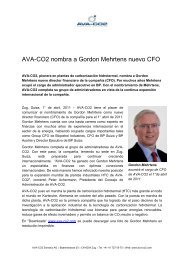Nicole Willimann - AVA-CO2
Nicole Willimann - AVA-CO2
Nicole Willimann - AVA-CO2
Create successful ePaper yourself
Turn your PDF publications into a flip-book with our unique Google optimized e-Paper software.
<strong>AVA</strong>-<strong>CO2</strong> introduces the first industrial-size hydrothermal<br />
carbonisation (HTC) plant in the world.<br />
<strong>AVA</strong>-<strong>CO2</strong>, pioneer of hydrothermal carbonisation (HTC), is today putting the first industrial-size<br />
HTC plant in the world into operation in Karlsruhe, Germany. The HTC tech-<br />
nology uses biomass for generating renewable energy, reducing greenhouse gases and enabling a<br />
neutral balance of <strong>CO2</strong>.<br />
Zug, Switzerland/Karlsruhe, Germany - 26th October, 2010 - by putting the world’s largest<br />
hydrothermal carbonisation (HTC) plant into operation today, <strong>AVA</strong>-<strong>CO2</strong> succeeds as the first<br />
company to take the step from research towards industrial use of HTC technology. With an<br />
overall capacity of 14,400 litres and an annual capacity to process 8,400 tonnes of biomass,<br />
the reactor presented today demonstrates in an impressive way that the experts from <strong>AVA</strong>-<br />
<strong>CO2</strong> have succeeded in constructing and operating a plant of industrial-size. About 100 invited<br />
guests from research, industry and politics are expected to attend the inauguration of<br />
the plant at the site of <strong>AVA</strong>-<strong>CO2</strong>'s subsidiary at Karlsruhe.<br />
“On an industrial scale, hydrothermal carbonisation (HTC) opens completely new perspec-<br />
tives on the reduction of greenhouse gases and the production of renewable energy by processing<br />
biomass into <strong>CO2</strong>-neutral biocoal," explains the Chairman of the Board, Peter Achermann.<br />
"Wherever larger quantities of biomass accumulate continuously, the HTC process can be<br />
used profitably by a large number of industries and applications," adds Jan Vyskocil, Co-<br />
CEO of <strong>AVA</strong>-<strong>CO2</strong>.<br />
<strong>AVA</strong>-<strong>CO2</strong> with headquarters in Zug, Switzerland, is a pioneer of HTC technology and<br />
brought the procedure to industrial maturity. The HTC plant presented today by <strong>AVA</strong>-<strong>CO2</strong><br />
consists of three main components: the biomass is mixed and heated up to around 150°C in<br />
the five-metre high mixing tank (to the right in the picture). In the centre there is the actual<br />
reactor, in which the chemical reaction takes place at about 220°C and at a pressure of 22<br />
bar. With its overall capacity of 14 cubic metres, this tank is silvery on account of an additional<br />
isolation layer. The largest tank (to the left in the picture) serves as a so-called outlet<br />
buffer tank for intermediate storage of the extracted energy and of the end product. This<br />
process developed by <strong>AVA</strong>-<strong>CO2</strong>, allows seamless integration in the continuous production<br />
processes of customers.<br />
<strong>AVA</strong>-<strong>CO2</strong> Schweiz AG Baarerstrasse 20 CH-6304 Zug Tel: +41 41 727 09 70 Web: www.ava-co2.com
Various pictures at printable resolution are available in the<br />
download section under www.ava-co2.com.<br />
Hydrothermal Carbonisation (HTC)<br />
The first industrial size plant in<br />
the world for hydrothermal carbonisation<br />
of biomass at the site<br />
of <strong>AVA</strong>-<strong>CO2</strong>'s subsidiary at<br />
Karlsruhe: mixing tank, reactor<br />
and outlet buffer tank (from right<br />
to left). The reactor has an overall<br />
capacity of 14,400 litres and<br />
an annual processing capacity of<br />
8,400 tonnes of biomass. The<br />
reactor works at temperatures of<br />
around 220°C and at a pressure<br />
of 22 bar. At customer sites a<br />
industrial HTC plant will typically<br />
consist of 8-12 reactors and thus<br />
achieve an annual capacity of<br />
65,000 to 100,000 tonnes of<br />
biomass.<br />
Under heat and pressure, the HTC process removes water molecules from the biomass and<br />
converts the residual carbon to high-value biocoal within a few hours. For that purpose, the<br />
biomass is heated up as an aqueous solution in a pressurised vessel. Subsequently, an exothermic<br />
process takes place, so that no further additional energy is required for the operation<br />
of the plant. Hydrothermal carbonisation is characterised among other things by the possibility<br />
of also processing biomass with high water content.<br />
The HTC process is most robust and uses all the existing carbon in the biomass. High-value,<br />
<strong>CO2</strong>-neutral, <strong>AVA</strong> blue coal is produced as the end product. Thanks to its stability and high<br />
energy density, this biocoal can be stored without any problem and transported efficiently. As<br />
an alternative, <strong>AVA</strong> biochar can also be produced with the HTC process. This product is<br />
similar to humus and is used in agriculture for soil ameliorisation and to capture <strong>CO2</strong>. The<br />
process of hydrothermal carbonisation was researched by Friedrich Bergius in 1913. In 1931,<br />
he was awarded the Nobel Prize in chemistry.<br />
<strong>AVA</strong>-<strong>CO2</strong> Schweiz AG Baarerstrasse 20 CH-6304 Zug Tel: +41 41 727 09 70 Web: www.ava-co2.com
About <strong>AVA</strong> <strong>CO2</strong><br />
<strong>AVA</strong>-<strong>CO2</strong> offers world-wide solutions to convert biomass into a sustainable source of energy.<br />
As a pioneer in hydrothermal carbonisation (HTC), <strong>AVA</strong>-<strong>CO2</strong> plans, implements and operates<br />
HTC plants on behalf of its customers. These facilities turn plant residues efficiently and<br />
profitably into high grade biocoal or biochar. The process binds greenhouse gases ensuring<br />
<strong>CO2</strong> neutrality. The Company is registered in Zug, Switzerland with a subsidiary in<br />
Karlsruhe, Germany. In October 2010, it launched the world’s first industrial-size HTC plant.<br />
www.ava-co2.com<br />
Contact<br />
Thomas M. Kläusli<br />
CMO and Public Relations<br />
<strong>AVA</strong>-<strong>CO2</strong> Schweiz AG<br />
Baarerstrasse 20<br />
CH-6304 Zug<br />
Phone: +41 41 727 09 70<br />
Mobil: +41 78 936 74 81<br />
E-Mail: media@ava-co2.com<br />
www.ava-co2.com<br />
<strong>AVA</strong>-<strong>CO2</strong> Schweiz AG Baarerstrasse 20 CH-6304 Zug Tel: +41 41 727 09 70 Web: www.ava-co2.com











